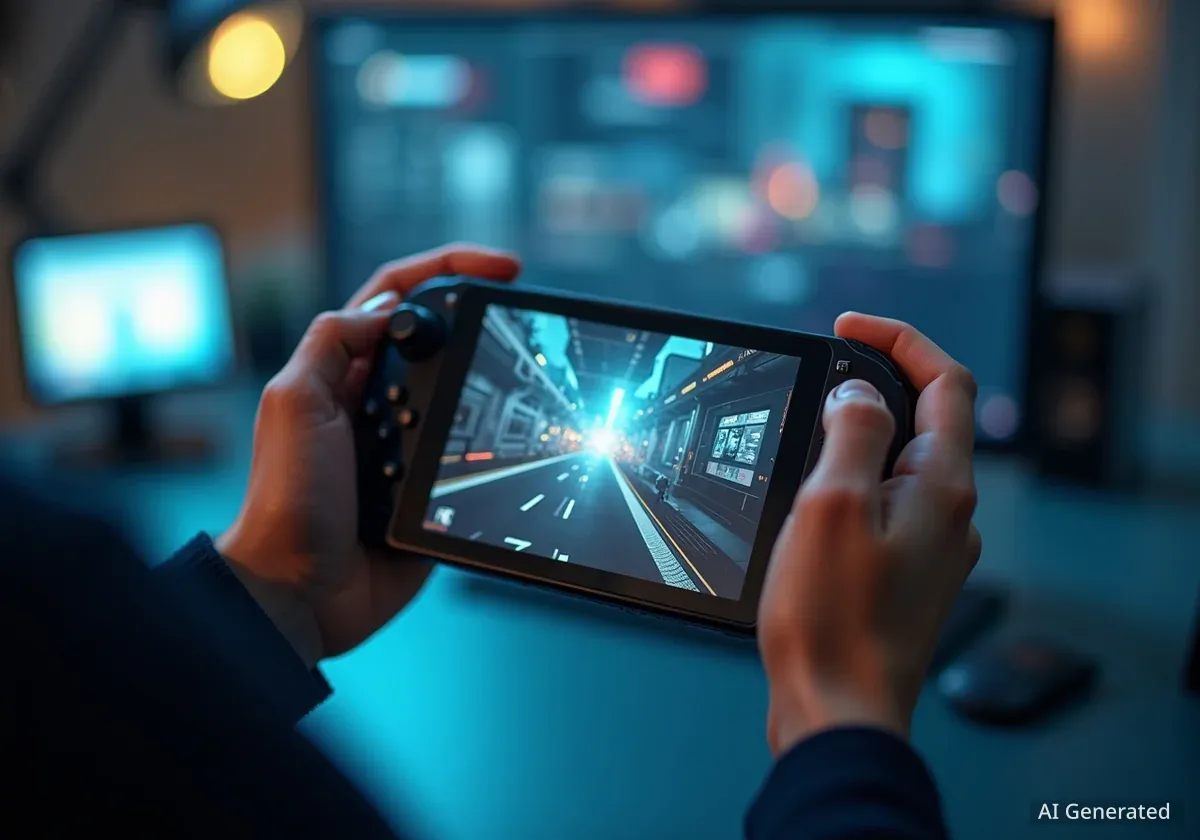OneXPlayer has announced a new high-performance handheld gaming PC, the OneXFly Apex. The device is set to feature AMD's latest Ryzen AI Max+ 395 processor and an unprecedented option for up to 128 GB of RAM, positioning it at the very top of the portable gaming market.
Key Takeaways
- The OneXFly Apex will be powered by the AMD Ryzen AI Max+ 395 processor with a Radeon 8060S iGPU.
- It offers memory configurations up to 128 GB, a new benchmark for handheld devices.
- The device features a 120W Thermal Design Power (TDP) supported by a liquid cooling system.
- It includes an 8-inch, 120 Hz VRR display and an 85 WHr removable battery.
Core Specifications and Performance
OneXPlayer is positioning the OneXFly Apex as a flagship device, focusing on raw performance capabilities that exceed current market offerings. The company's preliminary announcement outlines a set of specifications aimed directly at hardcore gamers and technology enthusiasts.
The New AMD Strix Halo Processor
At the heart of the OneXFly Apex is the AMD Ryzen AI Max+ 395, a high-end Accelerated Processing Unit (APU) from the Strix Halo series. This processor contains 16 cores with clock speeds reaching up to 5.1 GHz. This high core count and frequency suggest the device will be capable of handling demanding PC games and multitasking workloads.
Integrated graphics are managed by the Radeon 8060S, which features 40 Compute Units (CUs). This integrated GPU is designed to deliver performance comparable to some discrete laptop graphics cards, making it suitable for modern gaming titles at high settings.
Processor at a Glance
- Model: AMD Ryzen AI Max+ 395
- Architecture: Strix Halo
- CPU Cores: 16
- Max Clock Speed: 5.1 GHz
- iGPU: Radeon 8060S (40 CUs)
Unprecedented Memory and Display
One of the most notable specifications is the option for up to 128 GB of RAM. This amount of memory is far beyond what is currently available in any consumer handheld gaming device and is more typical of high-end desktop workstations. This suggests the OneXFly Apex is designed for more than just gaming, potentially targeting users who need significant memory for productivity or creative applications on the go.
The device will feature an 8-inch display with a native landscape orientation, which avoids the screen orientation issues seen in some earlier handhelds. The screen supports a 120 Hz refresh rate and Variable Refresh Rate (VRR) technology. VRR helps to synchronize the display's refresh rate with the GPU's frame output, resulting in smoother gameplay with less screen tearing.
Power, Cooling, and Battery Life
The performance claims for the OneXFly Apex are supported by an ambitious power and cooling design. The company announced a 120-watt Thermal Design Power (TDP), which is exceptionally high for a device of this size.
Understanding TDP in Handhelds
Thermal Design Power (TDP) measures the maximum amount of heat a component, like a processor, can generate that the cooling system is designed to dissipate. A higher TDP allows the processor to run at faster speeds for longer periods, increasing performance but also generating more heat and consuming more battery.
A 120W Power Target
The 120W TDP is a key feature that allows the Ryzen AI Max+ 395 processor to operate at its full potential. In comparison, many competing handhelds operate in the 15W to 45W range. According to OneXPlayer, this high power limit is necessary to maximize the performance of the 16-core APU.
To manage the heat generated by this high power draw, the device incorporates a "silent liquid cooling" system. While specific details were not provided, this terminology often refers to a vapor chamber or a similar advanced thermal solution designed to efficiently move heat away from the processor without excessive fan noise.
"120W power unleashed with silent liquid cooling," stated OneXPlayer in its social media announcement, highlighting the focus on maximizing performance without compromising acoustics.
Battery and Power Management
Powering the OneXFly Apex is an 85 WHr battery described as "removable." Based on initial renders, this appears to be an internal battery that can be replaced, rather than a hot-swappable external pack. Running at the full 120W TDP would theoretically drain this battery in less than an hour. However, real-world gaming scenarios rarely push all CPU and GPU cores to their maximum simultaneously.
It is also not yet clear if the full 120W TDP will be accessible while running on battery power alone, as some devices restrict performance when not plugged in. Users will likely be able to use the included OneXConsole software to create custom power profiles, balancing performance and battery life based on their needs.
Design, Controls, and Market Context
The OneXFly Apex maintains a familiar handheld form factor, with design cues taken from other popular devices in the market. It features an asymmetrical joystick layout, similar to the ASUS ROG Ally, along with adjustable multi-stage triggers for precise input control. The device also includes dual speakers tuned by Harman for improved audio quality.
Storage and Connectivity
For storage, the device will include a standard internal M.2 slot for high-speed SSDs. In addition, OneXPlayer has included an expandable Mini SSD slot on the exterior of the device, allowing for easy storage expansion without opening the chassis.
Competition and Pricing
The OneXFly Apex enters a competitive but niche market for high-end PC gaming handhelds. It will compete with devices like the GPD Win 5, which is also slated to use the same Strix Halo APU but with a lower 75W power limit. The GPD Win 5 is priced at $1,650 for its 32 GB model.
Given its higher specifications, the OneXFly Apex is expected to carry a premium price tag. While no official price has been announced, industry observers speculate that a model with comparable specs to competitors could start at over $1,500. The top-tier configuration with 128 GB of RAM could potentially reach as high as $2,500. This pricing firmly places the Apex in a category for enthusiasts who want the most powerful portable device available, regardless of cost.
Details regarding a final release date and official pricing are expected to be announced by OneXPlayer in the near future.





